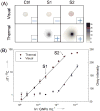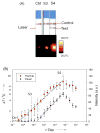Significantly improved analytical sensitivity of lateral flow immunoassays by using thermal contrast
- PMID: 22447488
- PMCID: PMC3337364
- DOI: 10.1002/anie.201200997
Significantly improved analytical sensitivity of lateral flow immunoassays by using thermal contrast
Figures




References
-
- Yager P, Edwards T, Fu E, Helton K, Nelson K, Tam MR, Weigl BH. Nature. 2006;442:412–418. - PubMed
- Martinez AW, Phillips ST, Whitesides GM, Carrilho E. Anal Chem. 2009;82:3–10. - PubMed
- Klostranec JM, Xiang Q, Farcas GA, Lee JA, Rhee A, Lafferty EI, Perrault SD, Kain KC, Chan WCW. Nano Lett. 2007;7:2812–2818. - PubMed
- Nam JM, Thaxton CS, Mirkin CA. Science. 2003;301:1884–1886. - PubMed
-
- Posthuma-Trumpie G, Korf J, van Amerongen A. Anal Bioanal Chem. 2009;393:569–582. - PubMed
-
- Liu J, Mazumdar D, Lu Y. Ang Chem Int Ed. 2006;45:7955–7959. - PubMed
-
- Chin CD, Laksanasopin T, Cheung YK, Steinmiller D, Linder V, Parsa H, Wang J, Moore H, Rouse R, Umviligihozo G. Nat Med. 2011;17:1015–1019. - PubMed
-
- Govorov AO, Richardson HH. Nano Today. 2007;2:30–38.
Publication types
MeSH terms
Substances
Grants and funding
LinkOut - more resources
Full Text Sources
Other Literature Sources

